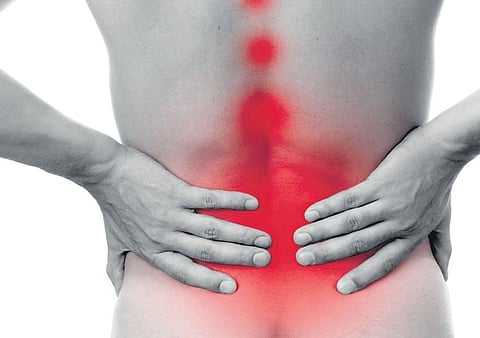

CHENNAI: A condition of lower back pain that radiates down to the legs, sciatica is most commonly found in people between 25 to 45 years of age. The estimated prevalence of sciatica has been found to be widely varying in medical literature, ranging from 1.2 per cent to 43 per cent in different studies. The condition derives its name from the sciatic nerve that branches down from the lower back through the hips to the legs. It is usually caused by a herniated disc that results in compression of a nerve, causing inflammation and pain in the areas affected by that particular nerve.
While the intensity of pain and distress is different from patient to patient, sciatica is a debilitating condition that negatively impacts the quality of life and productivity. In modern medicine, sciatica treatment involves the administration of anti-inflammatory drugs, muscle relaxants, and corticosteroid injections. However, prolonged use of these drugs is associated with adverse side effects on patients.
When the condition is severe enough to cause bowel or bladder changes or significant leg weakness, surgical intervention to remove a part of the herniated disc is considered. On the other hand, alternative therapies such as acupuncture in conjugation with physiotherapy have been found to be highly useful in reducing sciatica pain without any negative repercussions or major surgical intervention.
Acupuncture for sciatica
Acupuncture is a widely-used alternative therapy derived from traditional Chinese medicine. Acupuncture therapy is based on the belief that a vital force or energy circulates between the organs of the human body via certain channels or pathways. The disease is a result of a disorder occurring in the normal functioning of these pathways that obstructs the flow of vital energy. Acupuncture practice uses very fine needles on concerned points to remove the channel obstruction and stimulate the flow of energy and blood circulation.
Acupuncture points also stimulate sensory receptors which in turn induce the hypothalamus to release neurotransmitters and endorphins two essential elements in the body’s natural pain relief and healing mechanism. This theory postulates that there are over 2,000 such points that connect with 20 pathways in the human body. People struggling with chronic pain who fail to find effective medical solution in modern medicine often turn to acupuncture and find long-term relief.
Acupuncture is particularly useful for relief of chronic pain such as sciatica or arthritis pain. A comprehensive study published in the journal Evidence-Based Complementary and Alternative Medicine in 2015 analysed 12 previously conducted studies to gauge the impact of acupuncture on sciatica patients. The study concluded that acupuncture was more effective than conventional western medication in reducing pain intensity and increasing pain threshold in patients with sciatica. In fact, being a drugless and minimally-invasive procedure, acupuncture is one of the safest and most effective treatments for sciatica.
Physiotherapy
Physiotherapy is another critical element in the rehabilitation of sciatica patients. Physical therapy for sciatica patients may involve physiotherapists, chiropractors as well as spine rehabilitation experts working in tandem to offer pain relief and healing to the patient. This may be done in conjugation with conventional medicine as well as with acupuncture therapy.
A physical therapist will examine the patient in-depth and then prescribe a combination of therapies including manual therapy, soft tissue mobilisation and multiple back strengthening or stretching exercises. This will also include exercises to correct spine posture and adaptive mechanisms to prevent injuries and restore mobility. Physiotherapy provides symptom relief to sciatica patients and promotes healing of the underlying cause of the condition while preventing the recurrence of pain.
Yoga poses for relief
When performed consistently, yoga poses help align and strengthen the lower back while also helping to loosen the hip muscles. Spinal twist poses can also help address the pain arising out of nerve compression. Here are a few yoga poses to help relieve sciatica pain:
Gomukhasana
The cow face pose is one of the best poses for lengthening and stretching the spine and back muscles. To perform this asana, you have to sit on the floor in a staff pose. Then, draw your legs towards each other so that your knees are stacked on each other. Then, stretch out your arms behind your back, one stretching from down the shoulder and the other reaching out from down the other side. Now, try to touch and hold the fingers of both hands together.
Ardha Halasana
This asana helps stretch the hamstring and relieve sciatica pain. It involves lying down on your back
and gradually raising one leg up by keeping the knee straight. Maintain the final position for some time and keep taking deep breaths before slowly bringing the leg down. And then, repeat the pose with the other leg.
Ardha Matsyendrasana
This sitting half spinal twist pose gives the piriformis a mild stretch, also helps stretch the spine and back muscles while relieving stress on the hip muscles. To practise this pose, you have to sit on the floor, raise a leg knee up and twist your body one by one to each side. Twist your back as much as you comfortably can.